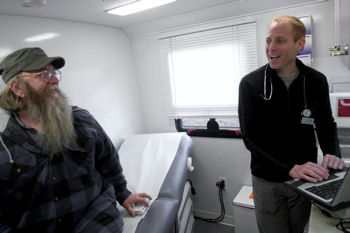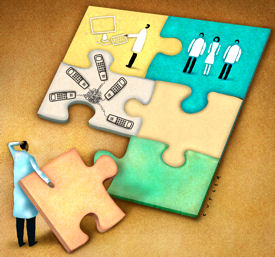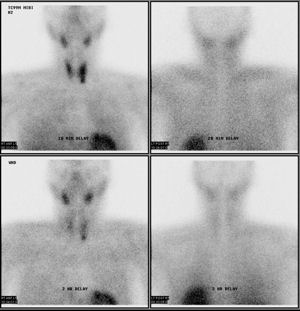Internists taking primary care to the streets
Practicing medicine changes when homeless patients don't have a phone, food or access to first aid. Free health care programs have been converting buses and vans into clinics on wheels as they discover that mobile care is an effective way to reach homeless patients.
When pediatrician Marsha Spitzer, MD, sees an adolescent patient for a skateboarding injury, she often can't tell him to stop by the pharmacy on his way home to buy bandages and ointment—many of her patients have no home and no money for first-aid supplies.
As a provider of health care for the homeless, Dr. Spitzer says, “We do a lot more of packing up a little brown baggie with some sterile gauze and tape and triple antibiotic ointment. With homeless youth, and even homeless adults, you have to provide a lot more of those kinds of resources in order for them to be able to do what you're asking of them.”
The provision of supplies is only one of the ways that Dr. Spitzer's current work differs from traditional primary care practice. Although most of her time is spent practicing at a community health center run by Family Health Care of San Diego (FHCSD), several nights a month she hits the streets, providing health care from a converted bus.
Over the past decade or two, free health care programs like FHCSD have been converting buses and vans into clinics on wheels as they discover that mobile care is an effective way to reach homeless patients.

“The outreach program grew out of our experience working in downtown Portland and understanding that a lot of the truly marginalized patient populations weren't coming into the clinic,” said Wayne Centrone, MD, medical director of outreach for Outside In, a social service agency in Portland, Ore.
Homeless health snapshot
The patients that the mobile programs treat are almost all uninsured, according to the directors of the various programs. Otherwise, they span wide age and demographic groups, although some programs target particular groups such as sex workers or undocumented immigrants who have little access to health care.
“About 90% of our patients have no medical insurance at all, so to a large degree if it weren't for us helping to care for them, they would be doing emergency room care,” said Bob Donovan, MD, medical director of the Cincinnati Health Network, which also provides mobile care.
Using the emergency department for non-emergent care is really the best scenario for much of this patient population, noted Dr. Centrone. “A lot of people just wait. They hope it's going to go away. ‘That lump I felt under my arm can't be that big of a deal. It's going to go away.’”
Like any primary care practice, the mobile practitioners see a mix of acute and chronic problems. “Hypertension, diabetes, trauma, dermatologic problems—those would be the top ones. Plenty of asthma and COPD,” said Dr. Donovan.
Adapting care
The homeless may have the same health problems as the general population, but they often require different therapies. A prescription made without an understanding of the patient's living situation can cause more problems than it solves, said Dr. Donovan.
“With high blood pressure, you've got to be extra cautious. If somebody doesn't have access to a restroom regularly, and you give them a diuretic, they've got a problem. You may end up getting them arrested for public indecency,” he explained.
A patient's limited access to food can also interact with prescribed treatments in devastating ways. “I've had a few people who went into renal failure because they weren't able to control their food. The same is true with diabetics. I'm a little more careful with any agents that can cause hypoglycemia,” said Tanya Page, MD, a family physician at Outside In.
Sometimes the circumstances of homelessness necessitate more treatment rather than less. “One of the hardest things is that sometimes we end up having to treat presumptively,” said Dr. Spitzer. She described the difficulty of taking a “wait and see” approach to an uncertain diagnosis for a young male patient who was living in Los Angeles the previous week, San Diego the following, and who could be anywhere the next.
“I may end up treating him for whatever I'm even thinking about that day knowing that there's a good chance I might not ever see him again,” she said.
Many patients do come back to the vans repeatedly, however. Most of the mobile programs were developed as outreach to bring patients into clinics, but patients' needs and wishes have changed the model in some cases.
“Originally, our model was we're going to go out and be a triage,” said Dr. Centrone. “What we've actually found is that the patients are more comfortable seeing us. They like coming back to the van for their services and now we do a lot of primary longitudinal care.”
Factors beyond control
There are potential problems with the mobile unit as a patient's sole source of care, noted Jennette Lawrence, FHCSD's director of government and community relations. “We never want the mobile unit to be the medical home. What if they have a fever and the unit's not going to be there for four days?”
But for some patients, the mobile clinic is their only option for a medical home. “There's a place we go twice a week where I think we are the only primary care provider for uninsured patients in that half of the county,” said Dr. Page.
The patients' need for care is part of what makes this work so fulfilling, several of the physicians said. “They're a little bit like kids who haven't been able to go to school. They're pretty excited about having access to care and access to medication,” said Dr. Page. “It's a really, truly sick population that is very appreciative of care. They are pretty adherent. They are good partners in their own care.”
When the patients have trouble adhering to treatment, it is often because of factors beyond their control.
“Sometimes we have diabetic patients back two or three times a month, if for nothing else than that they can't call in and tell us what their sugars are. They don't have a phone. They are barely able to hold on to the glucometer,” said Dr. Centrone.
Such situations require more than the average amount of understanding and sympathy on the part of the health care provider, said Dr. Page. “We don't yell at people for losing their medications. If people live in squats and their squats get raided, their stuff gets taken.”
Extra work on the part of the mobile care physicians is also required when the patients need more care than can be provided from a van. “We work constantly to try to bridge that socioeconomic gap that occurs when you've got a patient who needs a CT scan but doesn't have any insurance. How do you get that CT scan for them?” asked Dr. Centrone.
And once the doctor has arranged the CT scan, or an appointment with a specialist, how does he or she inform a patient without a phone or address? Almost every aspect of medical practice, from prescribing medications to giving referrals, is complicated by patients' housing status, the mobile care providers said. A large part of their job is connecting patients with social service programs that will help get them out of homelessness, which in turn will usually improve the patients' health.
“We have to be holistic. You can't make someone healthy if they are homeless,” said Matias Vega, MD, staff physician at Health Care for the Homeless in Albuquerque, N.M. He noted recent studies which have found homeless Americans' average age of death to be between 42 and 52 years, compared to almost 80 for people with housing.
The goals of physicians who provide mobile care to the homeless are very different from those of their colleagues in regular practice, Dr. Vega concluded. “The most important thing you can do as a health care professional is to get them out of homelessness. Almost everything else that we do is just a little bit of palliative care.”




